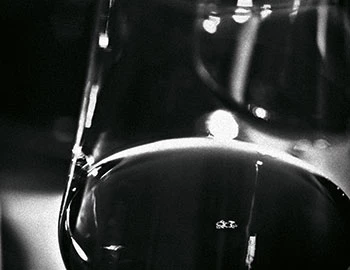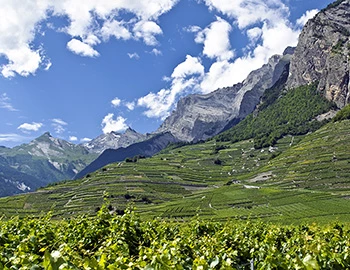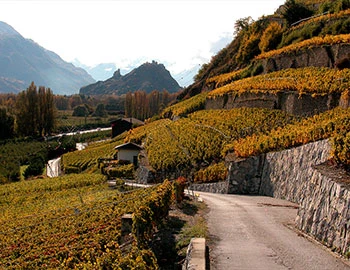
Humagne rouge 2023
AOC Wallis, Bonvin, 750 ml

| Grape variety: | Humagne rouge |
| Producer: | Bonvin |
| Origin: | Switzerland / Wallis |
Attributes
| Origin: | Switzerland / Wallis |
| Grape variety: | Humagne rouge |
| Ripening potential: | 2 to 5 years |
| Drinking temperature: | 16 to 18 °C |
| Food Pairing: | Beef Stroganoff, Roast saddle of venison, Wild specialities, Rabbit ragout with olives, Spicy hard cheese |
| Vinification: | fully destemmed, fermentation in steel tank, short must fermentation, pressed carefully and immediately |
| Harvest: | hand-picking, strict selection |
| Maturation: | in steel tank |
| Volume: | 13.5 % |
| Note: | Contains sulphites |
Humagne rouge
Wild wine
With this wine, you have a choice. Either drink it young, when its lush berry fruit dominates, or wait three to five years and experience its wild side. Even when young the Humagne rouge demonstrates echoes of tree bark and animal hide. These aromas truly come into their own with maturation. They are joined by hints of smoke, brushwood and pepper. The question of where it fits seems almost unnecessary: in the wild, of course. Its origins are confusing. The Humagne grape variety should have actually been called Cornalin. It is identical to the Cornalin from the Italian Aosta Valley. Another Valais grape – the Rouge du Pays – was erroneously named after this, which in turn operates mostly as Cornalin. Thus they are both falsely named.

Wallis
Valais: Alpine wines with class
More than 20 varieties of grapes can yield wines in Valais that are full of character. A large number of them grow on spectacular, steep slopes. Sealed off by mighty chains of mountains, old plantings like Petite Arvine, Amigne and Cornalin have survived in Valais, and today they are highly sought-after by wine enthusiasts. The highest vineyards in Europe are also found in Valais: the Savignin vines (known here as “Heida”), rooted in the mountain community of Visperterminen.

Switzerland
Switzerland – A small country with enormous diversity
Switzerland is famous for its banks, watches, and cheese, but not necessarily for its wine. The Swiss didn't invent wine, but they have been extremely open and curious to it. Wine culture arrived in what is now modern Switzerland via several routes: from Marseilles to Lake Geneva and the Lower Valais region; from the Aosta Valley through the Great St. Bernard Pass to the rest of Valais; from the Rhone through Burgundy, across the Jura Mountains to Lake Constance; and from Lombardy to Ticino, and then on to Grisons.


